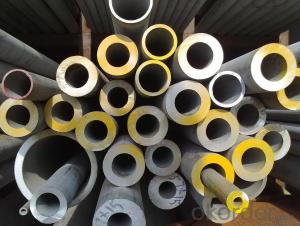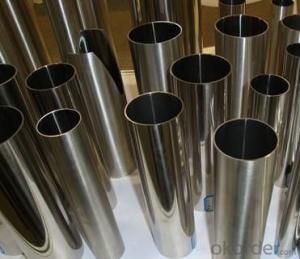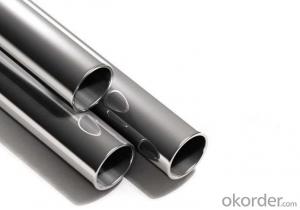316 Stainless Steel Pipe
- Loading Port:
- China main port
- Payment Terms:
- TT OR LC
- Min Order Qty:
- 5 m.t.
- Supply Capability:
- 100000 m.t./month
OKorder Service Pledge
OKorder Financial Service
You Might Also Like
Item specifice
SPECIFICATION
Stainless Steel Pipe:
1. 201, 202, 301, 304, 316L, 430, etc
2. OD: 6mm-159mm
3. Thickness: 0.25mm-3.5mm
4. Finish: Mirror, Satin, Hairline
316 STAINLESS STEEL PIPE:
Name | 316 Stainless steel pipe | |||||
Standard | ASTM A554,ASTM A312 | |||||
Material Grade | 201,202,304,316,316L,430 | |||||
Main Material
| a) 201 (Ni0.8%-1%) b) 202 (Ni: 3.0%-4.0%) d) 316 (Ni: 10% Cr: 18%) | |||||
Size Range | 139mm-1600mm ETC. | |||||
Thickness | 0.5-30mm | |||||
Length | 6m or as customers' request | |||||
Tolerance | a) Outer Diameter: +/- 0.2mm | |||||
b) Thickness: +/- 0.02mm | ||||||
c) Length: +/- 5mm | ||||||
Surface | 180G, 320G Satin/Hairline 400G, 600G Mirror finish | |||||
Application | handrail,railing, staircase, weldmesh screen,door,window, balcony,fence,bench,furniture,etc | |||||
Test | Squash test, extended test, water pressure test, crystal rot test, heat treatment, NDT | |||||
Chemical Composition of Material | 201 | 202 | 304 | 316L | 430 | |
C | ≤0.15 | ≤0.15 | ≤0.08 | ≤0.035 | ≤0.12 | |
Si | ≤1.00 | ≤1.00 | ≤1.00 | ≤1.00 | ≤1.00 | |
Mn | 5.5-7.5 | 7.5-10 | ≤2.00 | ≤2.00 | ≤1.00 | |
P | ≤0.06 | ≤0.06 | ≤0.045 | ≤0.045 | ≤0.040 | |
S | ≤0.03 | ≤0.03 | ≤0.030 | ≤0.030 | ≤0.030 | |
Cr | 13-15 | 14-17 | 18-20 | 16-18 | 16-18 | |
Ni | 0.7-1.1 | 3.5-4.5 | 8-10.5 | 10-14 | ||
Mo | 2.0-3.0 | |||||
Mechanical Property | Material Item | 201 | 202 | 304 | 316 | |
Tensile Strength | ≥535 | ≥520 | ≥520 | ≥520 | ||
Yield Strength | ≥245 | ≥205 | ≥205 | ≥205 | ||
Extension | ≥30% | ≥30% | ≥35% | ≥35% | ||
Hardness (HV) | <105< span=""> | <100< span=""> | <90< span=""> | <90 | ||

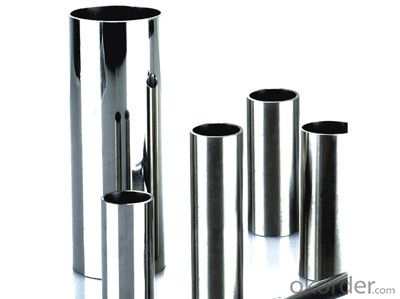
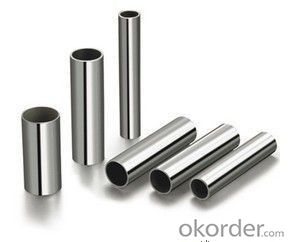
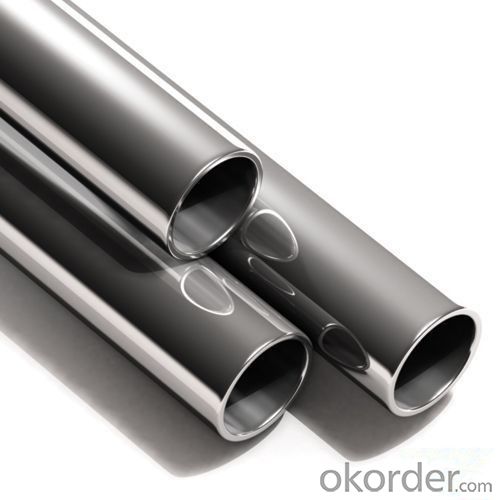
- Q:Are stainless steel pipes suitable for hygienic applications?
- Yes, stainless steel pipes are suitable for hygienic applications. Stainless steel is widely used in industries such as food processing, pharmaceuticals, and dairy, where maintaining cleanliness and preventing contamination is crucial. Stainless steel pipes have several properties that make them ideal for hygienic applications. Firstly, stainless steel is highly resistant to corrosion, which is important for maintaining hygiene and preventing the growth of bacteria or other pathogens. It does not rust or corrode easily, even when exposed to various chemicals and cleaning agents used in hygienic environments. This resistance to corrosion ensures the integrity of the pipes and prevents any contamination from occurring. Secondly, stainless steel has a smooth, non-porous surface that is easy to clean and sanitize. The smoothness of the surface prevents the accumulation of dirt, bacteria, or other particles, making it easier to maintain a hygienic environment. Stainless steel pipes can be easily cleaned using various cleaning methods, including steam, high-pressure water, or chemical cleaning agents. Furthermore, stainless steel is a durable and long-lasting material. It can withstand high temperatures and pressures, making it suitable for a wide range of hygienic applications. Stainless steel pipes can be used for transporting fluids, gases, or other materials without compromising their hygienic properties. In addition, stainless steel is a non-reactive material, meaning it does not react with the substances it comes into contact with. This property is important for preventing any contamination or alteration of the substances being transported through the pipes. Overall, stainless steel pipes are highly suitable for hygienic applications due to their corrosion resistance, smooth surface, durability, and non-reactive properties. They provide a reliable and hygienic solution for industries where cleanliness and prevention of contamination are of utmost importance.
- Q:What is the difference between 316 and 316L stainless steel pipes?
- The carbon content is the main distinguishing factor between 316 and 316L stainless steel pipes. Both alloys contain equal amounts of chromium, nickel, and molybdenum, which contribute to their corrosion resistance. However, 316L stainless steel pipes have a lower carbon content than 316 stainless steel pipes. The reduced carbon content in 316L stainless steel pipes helps prevent carbide precipitation during welding or high-temperature applications. This phenomenon, known as sensitization, can result in intergranular corrosion, compromising the overall corrosion resistance of the material. By reducing the carbon content, 316L stainless steel pipes are less prone to sensitization, making them more suitable for welding applications. Moreover, the lower carbon content in 316L stainless steel pipes enhances their resistance to corrosion in environments with high chloride exposure, such as coastal areas or industrial settings. This characteristic makes 316L stainless steel pipes the preferred choice in various industries, including marine, chemical, and pharmaceutical, where corrosion resistance is essential. To summarize, while both 316 and 316L stainless steel pipes offer excellent corrosion resistance, the lower carbon content of 316L stainless steel pipes improves weldability and resistance to sensitization. Therefore, 316L stainless steel pipes are commonly selected for applications involving welding or exposure to corrosive environments.
- Q:What is the difference between seamless and high-frequency welded stainless steel pipes?
- Two different types of pipes used in various applications are seamless stainless steel pipes and high-frequency welded stainless steel pipes. Seamless stainless steel pipes undergo a process called seamless pipe manufacturing. This involves heating and piercing a solid billet to create a hollow tube. The absence of seams or joints in seamless pipes makes them ideal for applications that require high pressure, high temperature, or corrosive environments. Their uniform composition and lack of welding contribute to their superior strength and reliability. In contrast, high-frequency welded stainless steel pipes are manufactured using high-frequency welding. This process includes passing a flat strip of stainless steel through rollers to form a tube shape. The edges of the strip are heated with high-frequency electrical currents and fused together, resulting in a solid pipe with a visible welded seam. Although both types of pipes are made from stainless steel, there are some differences between them. The manufacturing process is a significant distinction. Seamless pipes are created without any welding, resulting in a seamless and jointless pipe. On the other hand, high-frequency welded pipes have a visible welded seam along their length. Another difference lies in the strength and reliability. Seamless pipes, due to their uniform composition and absence of welding, offer higher strength and reliability compared to high-frequency welded pipes. This makes seamless pipes more suitable for applications that involve high pressure, high temperature, or corrosive environments. Moreover, the production cost of seamless pipes is generally higher than that of high-frequency welded pipes. The seamless pipe manufacturing process requires more complex machinery and additional steps, leading to higher production costs. Conversely, high-frequency welded pipes involve a simpler and more cost-effective manufacturing process. In summary, the main distinctions between seamless and high-frequency welded stainless steel pipes revolve around their manufacturing process, strength, and cost. Seamless pipes are made without any welding, providing higher strength and reliability at a higher cost. High-frequency welded pipes have a visible welded seam but are more cost-effective. The choice between the two types of pipes depends on the specific requirements of the application and the available budget.
- Q:Can stainless steel pipes be used for wastewater treatment systems?
- Yes, stainless steel pipes can be used for wastewater treatment systems. Stainless steel is a highly durable and corrosion-resistant material, making it an ideal choice for pipes in harsh environments such as wastewater treatment plants. These pipes can withstand the corrosive nature of wastewater, including the presence of chemicals and different pH levels. Stainless steel pipes also have a smooth surface, which helps to minimize the accumulation of waste and bacteria, ensuring the efficient flow of wastewater through the system. Additionally, stainless steel is easy to clean and maintain, making it a cost-effective and reliable choice for wastewater treatment systems.
- Q:How do you pressure test stainless steel pipes?
- To pressure test stainless steel pipes, you can use various methods, such as hydrostatic testing or pneumatic testing. Hydrostatic testing involves filling the pipes with water or another suitable liquid and pressurizing them to a specified level using a pump. The pressure is then maintained for a designated period to check for any leaks or failures. Pneumatic testing, on the other hand, involves using compressed air or gas to pressurize the pipes and conducting similar leak detection procedures. It is crucial to follow industry standards, guidelines, and safety measures while performing these tests to ensure the integrity and reliability of the stainless steel pipes.
- Q:How do stainless steel pipes compare to other materials like carbon steel or PVC?
- Stainless steel pipes have several advantages over other materials like carbon steel or PVC when it comes to various applications. Firstly, stainless steel pipes are renowned for their excellent corrosion resistance. They are resistant to rust, oxidation, and staining, making them suitable for use in environments with high moisture or chemical exposure. In contrast, carbon steel pipes are susceptible to corrosion and require protective coatings to prevent rusting, while PVC pipes are not resistant to certain chemicals and can degrade over time. Secondly, stainless steel pipes offer exceptional strength and durability. They can withstand high pressure and extreme temperatures, making them ideal for applications that require robust and long-lasting piping systems. Carbon steel pipes also possess good strength characteristics, but they may not be as resistant to corrosion as stainless steel. On the other hand, PVC pipes are relatively weaker and may not be suitable for high-pressure applications. Furthermore, stainless steel pipes have excellent hygienic properties. They are non-porous, smooth, and easy to clean, making them suitable for use in industries such as food and beverage, pharmaceuticals, and healthcare, where maintaining cleanliness and preventing bacterial growth is crucial. Carbon steel pipes, due to their porous nature, can accumulate contaminants and bacteria over time. PVC pipes, although easy to clean, may release certain chemicals into the water or fluids passing through them, which can be a concern in certain applications. Lastly, stainless steel pipes are highly versatile. They can be used in a wide range of applications, including water supply, gas pipelines, chemical processing, oil and gas exploration, and architectural purposes. Carbon steel pipes are also versatile but may require additional measures to prevent corrosion. PVC pipes, while suitable for certain applications, have limitations in terms of temperature and pressure ratings. Overall, stainless steel pipes offer superior corrosion resistance, strength, durability, and hygienic properties compared to carbon steel or PVC pipes. When choosing a piping material, it is essential to consider the specific requirements of the application to ensure optimal performance and longevity.
- Q:Can stainless steel pipes be used for vacuum systems?
- Yes, stainless steel pipes can be used for vacuum systems. Stainless steel is highly resistant to corrosion and has high strength, making it suitable for maintaining a vacuum environment without compromising its integrity.
- Q:Can stainless steel pipes be used for mining and mineral processing applications?
- Mining and mineral processing applications can utilize stainless steel pipes. The exceptional corrosion resistance of stainless steel makes it ideal for use in environments with exposure to chemicals, acids, and high temperatures commonly found in these operations. Stainless steel pipes provide several benefits in these applications. Firstly, their corrosion resistance ensures they can withstand harsh conditions, reducing the risk of pipe failure, and minimizing maintenance and replacement costs. Additionally, stainless steel pipes are highly durable and have a long lifespan, making them cost-effective in the long term. Moreover, stainless steel pipes are non-reactive and do not contaminate the materials they transport, which is crucial for maintaining product purity in mining and mineral processing. This makes them suitable for conveying various minerals, ores, and chemicals without compromising quality or causing contamination issues. Another advantage of stainless steel pipes is their versatility. They can be manufactured in different sizes, shapes, and thicknesses to meet specific requirements in mining and mineral processing. Additionally, stainless steel pipes can be easily connected to other components and systems through welding, threading, or coupling, allowing for efficient installation and integration into existing infrastructure. In conclusion, stainless steel pipes are an excellent choice for mining and mineral processing applications due to their corrosion resistance, durability, non-reactivity, and versatility. They provide a reliable and cost-effective solution for conveying various materials in demanding environments while maintaining the integrity and purity of processed products.
- Q:How do you calculate the pipe length required for a specific application?
- To calculate the pipe length required for a specific application, there are several factors that need to be considered. 1. Flow Rate: Determine the desired flow rate or the amount of fluid to be transported through the pipe per unit of time. This can be measured in gallons per minute (GPM), liters per second (L/s), or any other appropriate unit. 2. Pipe Material: Identify the material of the pipe that will be used for the application. Different materials have different friction coefficients, which will affect the overall length required. 3. Friction Loss: Calculate the friction loss in the pipe based on the flow rate and the material properties. This involves determining the friction factor for the specific pipe material and using the appropriate equation (such as Darcy-Weisbach equation or Hazen-Williams equation) to calculate the friction loss. 4. Pressure Drop: Consider the desired pressure drop across the pipe. This is typically specified by the application requirements or system design. The pressure drop can be calculated using the Bernoulli's equation or other relevant equations. 5. Pipe Diameter: Determine the appropriate pipe diameter based on the desired flow rate and the allowable pressure drop. This can be done by using pipe sizing charts or equations specific to the pipe material and the flow characteristics. 6. Pipe Length Calculation: Once the pipe diameter is known, calculate the length required based on the desired flow rate, pressure drop, and the friction loss. This can be done using various pipe sizing equations or software tools available for the specific pipe material. 7. Additional Factors: Consider any additional factors that may affect the pipe length calculation, such as elevation changes, fittings, valves, or other components in the system. These factors may introduce additional friction losses or pressure drops that need to be accounted for. It is important to note that pipe length calculations are typically performed by engineers or professionals with expertise in fluid mechanics and pipe system design. Consulting relevant codes, standards, and guidelines specific to the application is also recommended to ensure compliance with safety and performance requirements.
- Q:Can stainless steel pipes be used in high-pressure applications?
- Yes, stainless steel pipes can be used in high-pressure applications. Stainless steel is known for its strength, durability, and ability to withstand extreme pressure conditions. It is often used in industries such as oil and gas, chemical processing, and power generation, where high-pressure environments are common. Stainless steel pipes offer excellent resistance to corrosion, making them suitable for long-term use in high-pressure applications.
1. Manufacturer Overview |
|
|---|---|
| Location | |
| Year Established | |
| Annual Output Value | |
| Main Markets | |
| Company Certifications | |
2. Manufacturer Certificates |
|
|---|---|
| a) Certification Name | |
| Range | |
| Reference | |
| Validity Period | |
3. Manufacturer Capability |
|
|---|---|
| a)Trade Capacity | |
| Nearest Port | |
| Export Percentage | |
| No.of Employees in Trade Department | |
| Language Spoken: | |
| b)Factory Information | |
| Factory Size: | |
| No. of Production Lines | |
| Contract Manufacturing | |
| Product Price Range | |
Send your message to us
316 Stainless Steel Pipe
- Loading Port:
- China main port
- Payment Terms:
- TT OR LC
- Min Order Qty:
- 5 m.t.
- Supply Capability:
- 100000 m.t./month
OKorder Service Pledge
OKorder Financial Service
Similar products
New products
Hot products
Hot Searches
Related keywords
